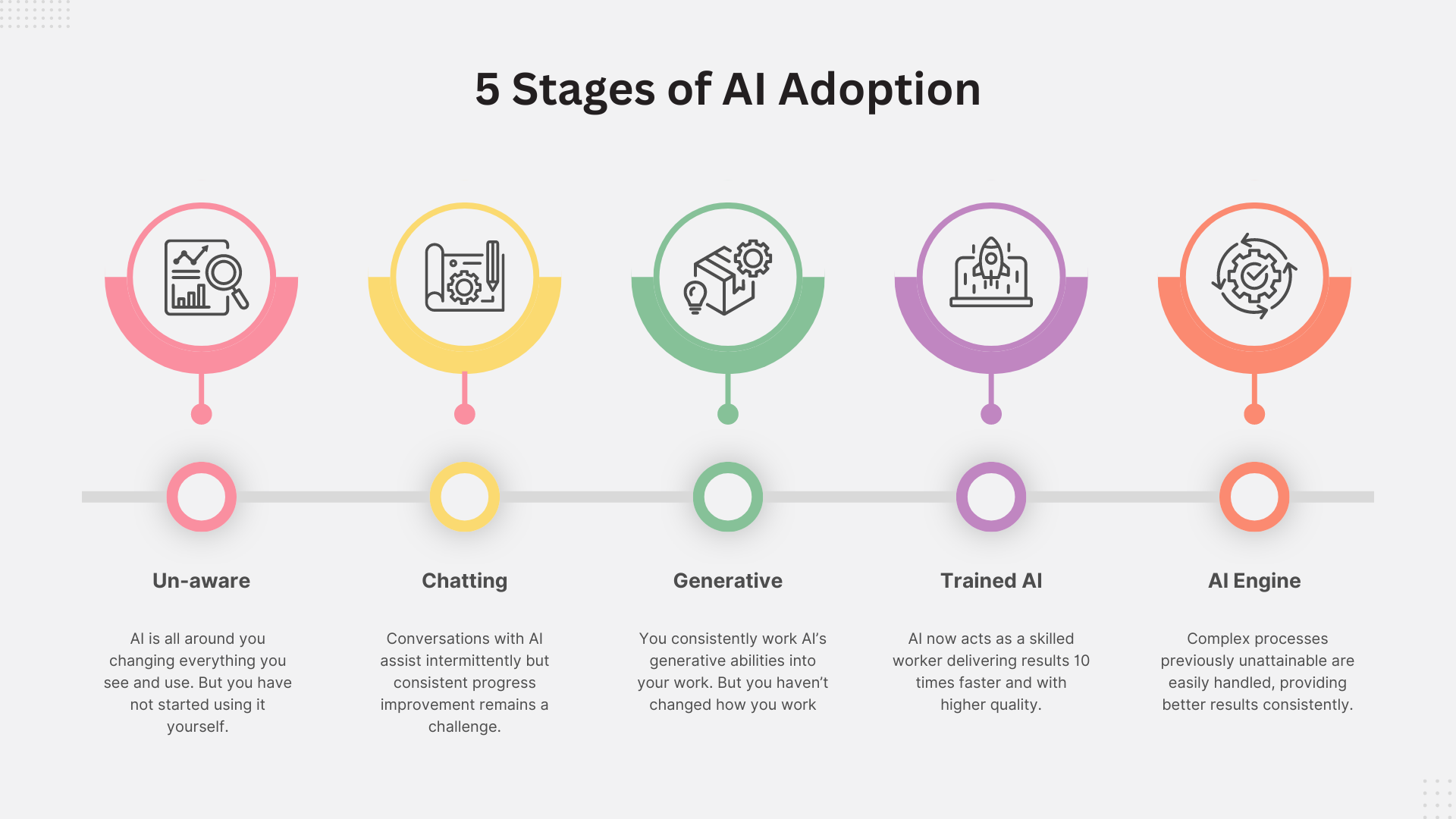Mastering Marketing with AI: Expert Tips & Insights
Welcome to your AI Marketing Hub
Your gateway to cutting-edge AI tools and expert-led courses.
Access your training platform, AI tools, and course details through your personalized dashboard.
Empowering your digital marketing journey with AI-driven insights and strategies.
Students access only
Topics
AI Basics for Work: Beginners
"AI adoption is determining your potential to compete."
Joe McKenna

AI Marketing Engine vs. Manuel Labor
AI is the moving assembly line for your marketing.
The Anti-Engine Manual Labor
Instead of a centralized, automated system, imagine a fragmented, manual process where each marketing task is handled individually, without integration or automation.
- Labor-Intensive: Every task requires human intervention.
- Limited Scale: As the workload increases, you need more people.
- Inconsistency: Multiple people make consistent quality challenging.
- Inflexibility: Adapting requires extensive retraining and process changes.
- Time-Consuming: Processing data, insights happen at human speed – meaning days or weeks for complex tasks.
Definition of an Engine
An engine is a core system or framework designed to perform a specific set of complex tasks efficiently and repeatedly. It's the "heart" of a larger system, driving its primary functions.
Purpose of an Engine
- Automation: Streamline repetitive tasks
- Scalability: Handle increasing workloads efficiently
- Consistency: Ensure uniform output and performance
- Flexibility: Adapt to various inputs and scenarios
- Power: Process complex operations quickly
Manual Marketing Approach
A fragmented process where marketing tasks are handled individually without integration or automation.
Traditional, hands-on method for executing marketing tasks.
The manual approach relies heavily on human intervention for all tasks:
- Labor-Intensive: Each task requires direct human action, from ideation to distribution.
- Limited Scale: Increasing output means hiring more staff.
- Inconsistency: Maintaining brand voice across channels is challenging.
- Inflexibility: Adapting to new platforms or content types requires extensive retraining.
- Time-Consuming: Tasks like data processing and content creation happen at human speed.
Result: Days to produce a single piece of content, difficulty in scaling, inconsistent brand voice, and limited capacity for experimentation due to time constraints.
AI Marketing Engine
A powerful, automated system that efficiently performs complex marketing tasks at scale.
Streamlines and supercharges your entire marketing process.
AI Marketing Engines automates and optimizes your marketing efforts:
- Automation: Handles repetitive tasks like content ideation and distribution.
- Scalability: Effortlessly manages increased workload without additional staff.
- Consistency: Maintains brand voice across all channels as output grows.
- Flexibility: Adapts to various content types and platforms seamlessly.
- Power: Processes vast amounts of data for quick insights and content creation.
Result: Transform weeks of work into days or hours, allowing you to focus on strategy and innovation while the engine handles execution.
We've seen the impact of life changing innovation before
Answered a question
One Video, Limitless Possibilities!
Answered a question
One Video, Limitless Topics
Use this prompt
AI Prompt: Generate Content Ideas from Video Transcript
You are a content creation expert tasked with generating diverse content ideas based on a given video transcript. Follow these steps to create a wide range of content suggestions:
Analyze the transcript:
Identify key topics, themes, and messages
Note any interesting quotes, statistics, or anecdotes
Recognize the overall tone and style of the content
Generate problem-solution pairs:
Identify 10 problems addressed in the video
For each problem, create a corresponding solution
Use the provided table format to organize these pairs
Apply copy formulas to problems and solutions:
Use the 10 provided copy formulas for each problem and solution
Create compelling titles and brief descriptions for each combination
Ensure variety in tone, style, and approach across formulas
Develop content ideas for various platforms:
Instagram Reels
Facebook Reels
YouTube Shorts
TikTok videos
For each platform, suggest:
5 short-form video concepts (15-60 seconds)
3 carousel post ideas
2 live stream topics
4 static post ideas
Create engagement-focused content:
3 poll ideas related to the video's topic
2 quiz concepts to test viewers' knowledge
4 question prompts to encourage comments
3 "fill in the blank" post ideas
Repurpose content for different formats:
2 blog post outlines based on the video's content
1 podcast episode concept
3 infographic ideas summarizing key points
2 email newsletter topics
Develop brand-specific content:
3 behind-the-scenes content ideas related to the video
2 customer success story concepts
4 tips or tricks posts showcasing expertise
1 challenge or contest idea related to the video's theme
Create evergreen content suggestions:
5 "Did you know?" facts from the video
3 myth-busting post ideas
2 how-to tutorial concepts
4 inspirational quote graphics from the transcript
Suggest content for specific occasions:
2 ideas for relevant awareness days or holidays
3 seasonal content concepts related to the video's topic
1 "Throwback Thursday" idea connecting past content to the video
Provide a content calendar outline:
Suggest a 30-day posting schedule incorporating the generated ideas
Balance content types and platforms for variety
Remember to tailor all content ideas to the brand's archetype, target audience, and overall marketing goals. Ensure that each suggestion aligns with the video's core message while providing value and encouraging engagement.
Format your response for rich text including tables.
Content Ideas from Indoor Air Quality Video Transcript
Key Topics:
- Indoor air quality
- Ventilation
- HVAC systems
- Spread of germs and viruses
Themes:
- Importance of good air circulation for health
- Limitations of HVAC systems
- Impact of poor air quality on health
Interesting Quotes:
- "Ventilation is the key to preventing the spread of germs and viruses."
- "Buildings are built today with windows that don't open."
- "Experts say you need about five air changes per hour to a typical HVAC system, maybe two and a half to three changes per hour."
Overall Tone and Style:
- Informative
- Conversational
- Slightly critical of current building practices
| Problem | Solution |
|---|---|
| Poor indoor air quality | Improve ventilation by opening windows when possible or using air purifiers with HEPA filters. |
| Limited air circulation from HVAC systems | Consider upgrading to a more powerful HVAC system with better air circulation capabilities. |
| Spread of germs and viruses through droplets in the air | Ensure proper ventilation, practice good hygiene, and consider using UV light air purifiers. |
| Buildings with non-opening windows | Advocate for building codes that require operable windows for better ventilation. |
| Insufficient air changes per hour | Install a system that achieves at least five air changes per hour for optimal air quality. |
| Copy Formula | Problem | Solution | Title | Description |
|---|---|---|---|---|
| Problem-Agitation | Tired of breathing in dirty air? | Invest in an air purifier with a HEPA filter! | Breathe Easy with Clean Air | Learn how a HEPA filter can remove harmful pollutants and improve your indoor air quality. |
| Before-After | Ever feel stuffy and uncomfortable in your home? | Imagine breathing in fresh, clean air all the time! | Transform Your Indoor Air Quality | Discover how to improve your air quality and feel the difference. |
| Question-Answer | Is your HVAC system really keeping your air clean? | Experts recommend at least five air changes per hour for optimal air quality. | Is Your HVAC System Up to the Task? | Explore the importance of proper air changes and how to achieve them. |
Instagram Reels:
- 5 Short-form Video Concepts (15-60 seconds):
- "5 Easy Ways to Improve Your Indoor Air Quality" - Show quick tips like opening windows, using air purifiers, and cleaning filters.
- "Why Your HVAC System Might Not Be Enough" - Explain the importance of air changes and how many are ideal.
- "Myth Busting: Do Air Purifiers Really Work?" - Demonstrate the effectiveness of air purifiers with a simple test.
- 3 Carousel Post Ideas:
- "5 Signs Your Indoor Air Quality Needs Improvement" - Visuals showing symptoms like allergies, fatigue, headaches, etc. with captions explaining the connection.
- "Top 3 Air Purifiers for Every Budget" - Showcase different air purifier models with their features and price points.
Facebook Reels:
- 5 Short-form Video Concepts (15-60 seconds):
- "Quick Tips for a Healthier Home: Air Quality Edition" - Share quick tips like dusting regularly, cleaning air vents, and using houseplants.
- "How to Choose the Right Air Purifier for Your Needs" - Guide viewers through the features to look for based on their specific needs.
YouTube Shorts:
- 5 Short-form Video Concepts (15-60 seconds):
- "The Truth About Your Air Conditioner" - Highlight the limitations of HVAC systems and why they might not be enough.
- "3 Simple Air Purifier Hacks" - Show quick tips for maximizing the efficiency of your air purifier.
TikTok Videos:
- 5 Short-form Video Concepts (15-60 seconds):
- "Air Quality Hack: Use This Everyday Object to Clean Your Air" - Use a common household item (like a houseplant) to demonstrate a simple air quality tip.
- "3 Ways Your HVAC System Could Be Making You Sick" - Share quick facts about HVAC system limitations and their impact.
Behind-the-Scenes Content:
- "Day in the Life of an HVAC Technician" - Show the daily work of your technicians and their expertise.
- "Inside Our Air Purifier Testing Lab" - Showcase your product development and testing procedures for quality assurance.
Customer Success Stories:
- "How [Customer Name] Improved Their Air Quality and Allergies" - Highlight a customer testimonial about how your products helped them.
- "From Sick to Healthy: One Family's Journey to Clean Air" - Tell the story of a family who struggled with poor air quality and found solutions.
Tips or Tricks Posts:
- "5 Easy Air Quality Tips for Every Home" - Provide simple and practical advice for improving air quality.
- "Air Purifier Myths Debunked: What Really Works" - Address common misconceptions about air purifiers and provide evidence-based advice.
Did You Know? Facts:
- Did you know that indoor air can be up to 5 times more polluted than outdoor air?
- Did you know that poor air quality can lead to health problems like allergies, asthma, and respiratory infections?
- Did you know that changing your air filters regularly can significantly improve your indoor air quality?
Myth-Busting Post Ideas:
- "Myth: Air purifiers are just for people with allergies." - Explain that clean air benefits everyone.
- "Myth: Opening windows is enough to improve air quality." - Highlight the limitations of opening windows and the need for other solutions.
How-to Tutorial Concepts:
- "How to Clean Your Air Filters: A Step-by-Step Guide" - Provide a visual tutorial on how to clean and maintain air filters.
- "How to Choose the Right Air Purifier for Your Home" - Offer a detailed guide on selecting the best air purifier based on features, size, and budget.
| Day | Platform | Content Idea |
|---|---|---|
| 1 | Air Purifier Hack Video | |
| 2 | Indoor Plant Power Carousel | |
| 3 | TikTok | Air Quality Dance Challenge |
| 4 | YouTube Shorts | Top 3 Indoor Air Pollutants |
| 5 | "Did You Know?" Fact about Indoor Air Quality |
Breathe Easy: 5 Steps to Improve Your Workspace Air Quality
We spend a significant portion of our day at work, and the air we breathe in the office can significantly impact our health, productivity, and overall well-being. You might be surprised to learn that indoor air quality can often be worse than outdoor air! This is due to a combination of factors, including pollutants from building materials, cleaning products, and even our own activities like printing or using certain equipment.
While we can't always control external factors, we can take steps to improve our workspace air quality and create a healthier environment. Here are 5 steps you can implement to breathe a little easier at work:
Open a Window:
Fresh air is your friend! Whenever possible, open a window to allow natural ventilation. This helps circulate fresh air and reduces indoor pollutants. Even a short period of time with the window open can make a difference. In some cases, opening a window may not be feasible due to external factors like noise or weather. If that's the case, consider other options like using a fan to circulate air within the workspace.
Dust Regularly:
Dust can harbor allergens, irritants, and even mold spores. Make it a habit to dust your workstation and surrounding area regularly. This includes cleaning surfaces, wiping down electronics, and vacuuming carpets. It might be helpful to designate a specific time each week to dust, and involve your colleagues in the process to create a shared sense of responsibility.
Consider an Air Purifier:
Investing in an air purifier with a HEPA filter can significantly improve air quality. HEPA (High-Efficiency Particulate Air) filters are designed to remove small particles from the air, including dust mites, pollen, mold spores, and pet dander. Look for models that are specifically designed for the size of your workspace and that have additional features like activated carbon filters to remove odors and VOCs (volatile organic compounds).
Stay Hydrated:
Believe it or not, staying hydrated can improve your air quality. Dehydration can lead to dry, irritated airways, making you more susceptible to allergies and other respiratory problems. Keep a water bottle at your desk and sip throughout the day. You can also set reminders or use a smart water bottle to ensure you're staying hydrated.
Advocate for Clean Air:
Spread awareness about the importance of indoor air quality and encourage your colleagues to take steps to improve their workspace air. Discuss clean air practices with your manager or colleagues and explore opportunities to improve air quality within the office. You can also suggest air quality monitoring devices to track pollutants and measure the impact of improvement efforts.
Risks of Poor Air Quality:
Poor air quality in the workplace can have a number of negative consequences, including:
- Respiratory Problems: Poor air quality can trigger or worsen respiratory problems like asthma, bronchitis, and allergies.
- Fatigue and Headaches: Pollutants can cause fatigue, headaches, and decreased concentration, making it difficult to focus on work.
- Increased Sick Days: Poor air quality increases the risk of getting sick, resulting in more missed workdays and decreased productivity.
- Reduced Cognitive Function: Poor air quality can lead to reduced cognitive function and impaired decision-making, impacting productivity and performance.
Taking action to improve your workspace air quality is an investment in your health and well-being. By following these simple steps, you can create a cleaner and healthier environment for yourself and your colleagues. Remember, clean air is not just a luxury, it's a fundamental aspect of a healthy and productive workplace.
What are your tips for improving workspace air quality? Share your thoughts in the comments below!
Title: The Air We Breathe: Improving Workspace Air Quality for a Healthier Workplace
Intro: Highlight the link between air quality and productivity, employee health, and company culture. Quantify the impact of improved air quality on productivity, employee health, and company culture with statistics or real-life examples.
Body: Focus on the benefits of improving air quality, emphasizing its impact on employee well-being and the bottom line. Discuss how clean air can boost employee morale, reduce absenteeism, and create a more positive work environment.
Conclusion: Encourage readers to share the article with colleagues and discuss strategies for improving air quality in their workplaces. Include a call to action, encouraging readers to reach out for a consultation or to download a free resource on improving air quality. Briefly mention any relevant industry standards or regulations that relate to air quality.
Tweet 1: We spend a lot of time at work, so it's crucial to prioritize our workspace air quality. #CleanAir #WorkplaceWellness
Tweet 2: Tip 1: Open a window to let in fresh air! Simple steps make a big difference. #Ventilation #HealthyWorkplace
Tweet 3: Tip 2: Dust regularly! Allergens and irritants can hide in dust. #Dusting #CleanAir
Tweet 4: Tip 3: Consider an air purifier with a HEPA filter to remove pollutants. #AirPurifiers #CleanAirSolution
Tweet 5: Tip 4: Stay hydrated! Dehydration can lead to dry, irritated airways. #Hydration #HealthyAirways
Tweet 6: Tip 5: Advocate for clean air! Encourage your colleagues to take steps to improve their workspaces. #CleanAirMovement
Tip: Use engaging questions or prompts (e.g., "What's your go-to air quality tip?"). Add a visual element by using images or short videos to accompany your tweets. Expand your hashtag use to include #worklifebalance, #wellbeing, #healthyspace, etc.
Post 1:"The air we breathe at work can affect our health and productivity. What steps do you take to improve your workspace air quality? #CleanAir #WorkplaceWellbeing"
Post 2:"Did you know that dust can harbor allergens and irritants? Dusting your workstation regularly can improve your air quality."
Post 3:"An air purifier with a HEPA filter can make a big difference in your workspace. What are your favorite air purifier brands? #AirPurifiers #CleanAirSolutions"
Tip: Ask questions that spark conversation and encourage interaction, such as "What's your biggest air quality concern at work?" Share real-life examples of companies that have improved their air quality. Use images and videos to capture attention and convey your message effectively.
Poll Question 1:"How often do you open a window for fresh air in your workspace?" - Options: Always, Often, Sometimes, Never, Other
Poll Question 2:"Have you considered using an air purifier in your workspace?" - Options: Yes, I'm using one now, Yes, I'm considering it, No, I haven't considered it, Other
Poll Question 3:"Do you think your workspace air quality needs improvement?" - Options: Yes, Definitely, Maybe, No, I'm satisfied, Other
Tip: Make your poll questions more specific and add an "Other" option to allow for diverse responses.









